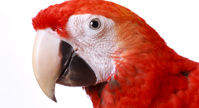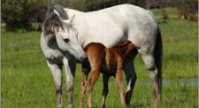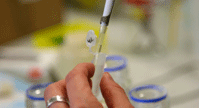Champagne Dilution
Description:
 The Champagne dilution gene lightens a horse's coat color by diluting the pigment. The specific color produced will depend on the horse's base color -- black coats can lighten to a dark brown, chestnut coats to an apricot or gold, and bay coats to a golden brown. A horse can carry more than one dilution gene which can further affect coat color.
The Champagne dilution gene lightens a horse's coat color by diluting the pigment. The specific color produced will depend on the horse's base color -- black coats can lighten to a dark brown, chestnut coats to an apricot or gold, and bay coats to a golden brown. A horse can carry more than one dilution gene which can further affect coat color.
Although similar to the cream, pearl and dun dilutions, the Champagne gene has certain characteristics that distinguish it from other dilutions. Common characteristics of a Champagne horse include pinkish freckled or mottled skin, a shiny coat that is often slightly darker in the winter, and a hazel eye color. Champagne horses are typically born with a blue eye color that evolves to a hazel or an amber coluor and pink skin that becomes darker and more freckled over time, especially around the eyes and muzzle. Champagne has been documented in the Quarter Horse, Tennessee Walker, American Saddlebred, Missouri Fox Trotter, Miniature Horses and several other breeds.
Base color Interaction of Champagne Dilution:
Classic champagne: Uniform black horses (excluding bay) are diluted to classic champagne. This involves the lightening of all body pigmentation to a pale-black color.
Gold champagne: chestnut/sorrel based horses are diluted to gold. Full coat modification occurs leading to uniform dilution of the body. Additionally, the gold horse will often have a flaxen mane and tail. Gold champagne horses are visually similar to chestnut-based horses modified by the cream gene (Palominos).
Amber champagne: Bay horses carrying champagne dilution are designated amber. Unlike coat dilutions that only work upon black pigment, the champagne will dilute the whole coat of the bay horse. Amber champagnes are sometimes referred to as amber buckskins.
Champagne dilution is caused by a dominant gene, meaning that a horse with a single copy of the Champagne gene will have Champagne characteristics. Unlike cream dilution, there are no visual differences between a horse with one copy or two copies of Champagne. A homozygous Champagne horse will always pass one copy of the Champagne gene to its foal. Heterozygous horses have a 50% chance of passing the gene on to its foals.
Animal Genetics offers testing for the dominant champagne gene-mutation. DNA testing may be useful in cases whereby a horse has previously tested negative for cream or silver dilutions, but appears to have a lightened-coat. Testing is also used to determine Homozygosity of the champagne gene.
Test Results:
Animal Genetics offers DNA testing for the champagne gene. The genetic test verifies the presence of the champagne mutation and presents results as one of the following:
| Ch/Ch | Champagne | Positive for dominant champagne gene, possessing two inherited copies. Coat will be diluted accordingly. Will pass champagne gene to all foals regardless of mate. |
| n/Ch | Champagne | Positive for dominant champagne gene, possessing one inherited copy. Coat will be diluted accordingly. Will pass champagne gene to approximately 50% of foals when bred. |
| n/n | Negative | Non-champagne horse. |
Submit a Sample for Testing:
To submit a sample for testing please click on ORDER and download a sample submission form. Then follow the sample collection and submission instructions.
Cost per sample is $25.00. Please see our Equine Fee Schedule for all equine testing rates.










